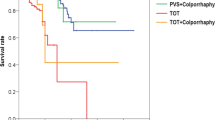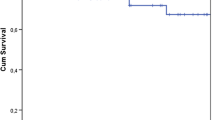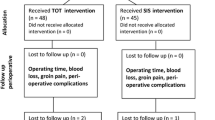Abstract
Introduction and hypothesis
To compare the late complication profiles between retropubic and transobturator slings used for stress urinary incontinence was the objective of the study.
Methods
Between the years 2003 and 2010, 338 complications of midurethral slings were surgically managed in a tertiary referral center. For the purpose of study, we excluded slings that had materials other than monofilament polypropylene, patients with previous anti-incontinence surgeries, and patients who were suspected of having a neurologic bladder condition. This is a prospective and retrospective study of the complications of midurethral slings. The characteristics of complications in retropubic and transobturator routes were compared and analyzed.
Results
Two hundred eighty cases with midurethral sling complications were suitable for analysis. Of these, retropubic slings constituted 210 and transobturator 70. The time interval between the insertion of tape and onset of complications was similar in both groups. Within the two groups, obstructive symptoms were seen more frequently in the retropubic tapes group. Compared to the retropubic tapes group, the transobturator group had more number of complications related to persistent pain (10% tension-free vaginal tapes vs. 32% transobturator tapes), dyspareunia (3% vs. 18%), and tape-related infections (4% vs. 18%). There were no significant differences among the complication rates pertaining to de novo overactive bladder (49% vs. 44%), obstructive symptoms (48% vs. 30%), and contraction of sling material (5% vs. 8%).
Conclusions
Obstructive complications were seen more commonly in the retropubic tapes compared to the transobturator tapes. Transobturator tapes were more frequently associated with persistent pain, dyspareunia, and tape-related infections as compared to retropubic tapes.


Similar content being viewed by others
References
Novara G, Ficarra V, Boscolo-Berto R, Secco S, Cavalleri S, Artibani W (2007) Tension-free midurethral slings in the treatment of female stress urinary incontinence: a systematic review and meta-analysis of randomized controlled trials of effectiveness. Eur Urol 52(3):663–678
Novara G, Galfano A, Boscolo-Berto R, Secco S, Cavalleri S, Ficarra V, Artibani W (2008) Complication rates of tension-free midurethral slings in the treatment of female stress urinary incontinence: a systematic review and meta-analysis of randomized controlled trials comparing tension-free midurethral tapes to other surgical procedures and different devices. Eur Urol 53(2):288–308
Tsivian A, Mogutin B, Kessler O, Korczak D, Levin S, Sidi AA (2004) Tension-free vaginal tape procedure for the treatment of female stress urinary incontinence: long-term results. J Urol 172(3):998–1000
Kristensen I, Eldoma M, Williamson T, Wood S, Mainprize T, Ross S (2010) Complications of the tension-free vaginal tape procedure for stress urinary incontinence. Int Urogynecol J Pelvic Floor Dysfunct 21(11):1353–1357
Juma S, Brito CG (2007) Transobturator tape (TOT): two years follow-up. Neurourol Urodyn 26(1):37–41
Chen Z, Chen Y, Du GH et al (2010) Comparison of three kinds of mid-urethral slings for surgical treatment of female stress urinary incontinence. Urologia 77(1):37–41
Bracq A, Fourmarier M, Boutemy F et al (2006) Urodynamic changes after transobturator suburethral tape. Prog Urol 16(1):62–66
Botros SM, Miller JJ, Goldberg RP et al (2007) Detrusor overactivity and urge urinary incontinence following trans obturator versus midurethral slings. Neurourol Urodyn 26(1):42–45
Kaelin-Gambirasio I, Jacob S, Boulvain M, Dubuisson JB, Dällenbach P (2009) Complications associated with transobturator sling procedures: analysis of 233 consecutive cases with a 27 months follow-up. BMC Womens Health 9:28
Angioli R, Plotti F, Muzii L, Montera R, Panici PB, Zullo MA (2010) Tension-free vaginal tape versus transobturator suburethral tape: five-year follow-up results of a prospective, randomised trial. Eur Urol 58:671–677
Sajadi KP, Vasavada SP (2010) Overactive bladder after sling surgery. Curr Urol Rep 11(6):366–371
Holmgren C, Nilsson S, Lanner L, Hellberg D (2007) Frequency of de novo urgency in 463 women who had undergone the tension-free vaginal tape (TVT) procedure for genuine stress urinary incontinence—a long-term follow-up. Eur J Obstet Gynecol Reprod Biol 132(1):121–125
Schimpf MO, Patel M, O'Sullivan DM, Tulikangas PK (2009) Difference in quality of life in women with urge urinary incontinence compared to women with stress urinary incontinence. Int Urogynecol J Pelvic Floor Dysfunct 20(7):781–786
Doo CK, Hong B, Chung BJ et al (2006) Five-year outcomes of the tension-free vaginal tape procedure for treatment of female stress urinary incontinence. Eur Urol 50(2):333–338
Wang W, Zhu L, Lang J (2009) Transobturator tape procedure versus tension-free vaginal tape for treatment of stress urinary incontinence. Int J Gynaecol Obstet 104(2):113–116
Ross S, Robert M, Swaby C et al (2009) Transobturator tape compared with tension-free vaginal tape for stress incontinence: a randomized controlled trial. Obstet Gynecol 114(6):1287–1294
Feng CL, Chin HY, Wang KH (2008) Transobturator vaginal tape inside out procedure for stress urinary incontinence: results of 102 patients. Int Urogynecol J Pelvic Floor Dysfunct 19(10):1423–1427
Roth TM (2007) Management of persistent groin pain after transobturator slings. Int Urogynecol J Pelvic Floor Dysfunct 18(11):1371–1373
Mazouni C, Karsenty G, Bretelle F, Bladou F, Gamerre M, Serment G (2004) Urinary complications and sexual function after the tension-free vaginal tape procedure. Acta Obstet Gynecol Scand 83(10):955–961
Cholhan HJ, Hutchings TB, Rooney KE (2010) Dyspareunia associated with paraurethral banding in the transobturator sling. Am J Obstet Gynecol 202(5):481, e1-5
Latthe PM, Foon R, Toozs-Hobson P (2007) Transobturator and retropubic tape procedures in stress urinary incontinence: a systematic review and meta-analysis of effectiveness and complications. BJOG 114(5):522–531
Deffieux X, Daher N, Mansoor A, Debodinance P, Muhlstein J, Fernandez H (2010) Transobturator TVT-O versus retropubic TVT: results of a multicenter randomized controlled trial at 24 months follow-up. Int Urogynecol J Pelvic Floor Dysfunct 21(11):1337–1345
Charalambous S, Touloupidis S, Fatles G et al (2008) Transvaginal vs transobturator approach for synthetic sling placement in patients with stress urinary incontinence. Int Urogynecol J Pelvic Floor Dysfunct 19(3):357–360
Mellier G, Mistrangelo E, Gery L, Philippe C, Patrice M (2007) Tension-free obturator tape (Monarc Subfascial Hammock) in patients with or without associated procedures. Int Urogynecol J Pelvic Floor Dysfunct 18(2):165–172
But I (2005) Vaginal wall erosion after transobturator tape procedure. Int Urogynecol J Pelvic Floor Dysfunct 16(6):506–508
Domingo S, Alamá P, Ruiz N, Perales A, Pellicer A (2005) Diagnosis, management and prognosis of vaginal erosion after transobturator suburethral tape procedure using a nonwoven thermally bonded polypropylene mesh. J Urol 173(5):1627–1630
Novara G, Artibani W, Barber MD et al (2010) Updated systematic review and meta-analysis of the comparative data on colposuspensions, pubovaginal slings, and midurethral tapes in the surgical treatment of female stress urinary incontinence. Eur Urol 58(2):218–238
Lowery WJ, Dooley Y, Kost E (2010) Small-pore polypropylene slings: still out there. Int Urogynecol J Pelvic Floor Dysfunct 21(1):125–127
Flam F, Boijsen M, Lind F (2009) Necrotizing fasciitis following transobturator tape treated by extensive surgery and hyperbaric oxygen. Int Urogynecol J Pelvic Floor Dysfunct 20(1):113–115
Rardin CR, Moore R, Ward RM, Myers DL (2009) Recurrent thigh abscess with necrotizing fasciitis from a retained transobturator sling segment. J Minim Invasive Gynecol 16(1):84–87
Acknowledgement
This project was made possible through IUGA fellowship award funding 2010 to Dr. Kiran Ashok.
Conflicts of interest
None.
Author information
Authors and Affiliations
Corresponding author
Rights and permissions
About this article
Cite this article
Petri, E., Ashok, K. Comparison of late complications of retropubic and transobturator slings in stress urinary incontinence. Int Urogynecol J 23, 321–325 (2012). https://doi.org/10.1007/s00192-011-1535-8
Received:
Accepted:
Published:
Issue Date:
DOI: https://doi.org/10.1007/s00192-011-1535-8




